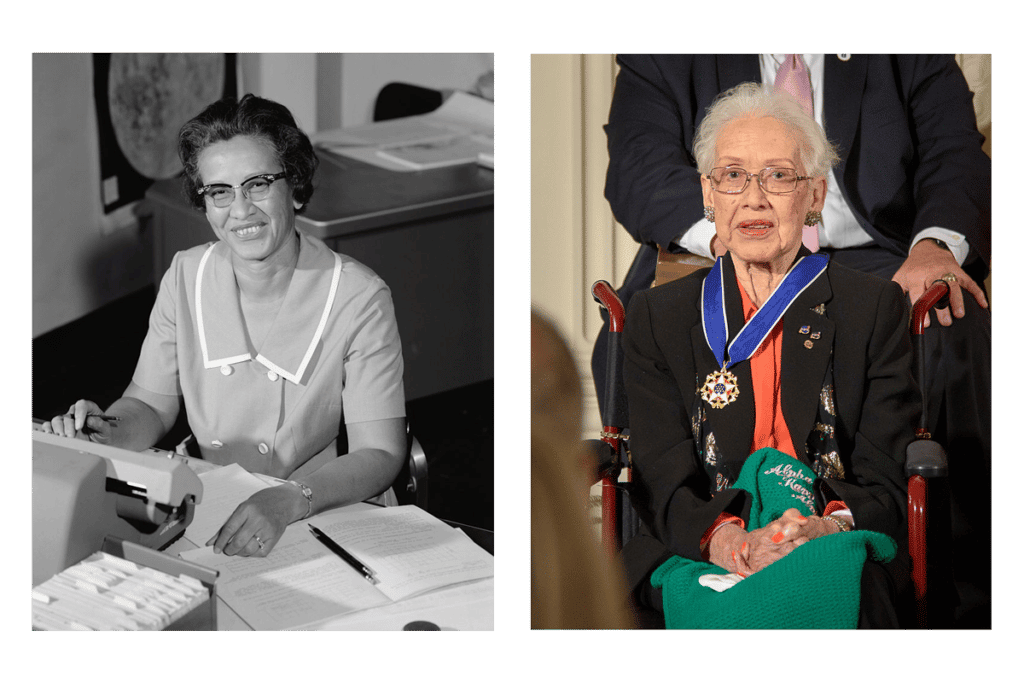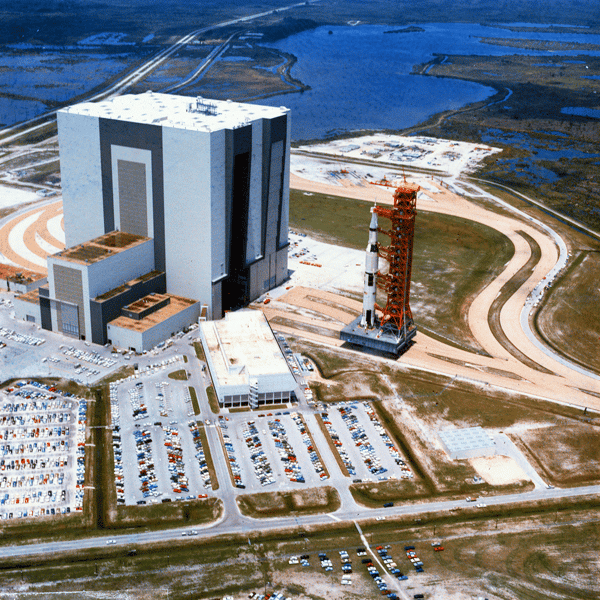Successful women in tech have one thing in common. They overcame the limitations of their time by defying what social norms or traditions of any kind demanded of them. Only in this way were they able to pursue their work and thus make their meaningful contribution to technological progress. Our Woman in Tech of today overcame not only the barriers she faced as a woman, but also the barriers she faced from racism in the United States. Today we’re talking about Katherine Johnson, a mathematician at NASA.
Katherine Johnson – Numbers, Boundaries, and Space
Who was Katherine Johnson?
Katherine Coleman Goble Johnson was almost literally reaching for the stars. She was a mathematician and worked at NASA for more than 30 years. By achieving what she did in her working environment, she overcame not only the discriminatory boundaries placed on women in her work environment, but also those of racial segregation, which was still very much present in her time. In doing so, Johnson never took an aggressive approach. The fact that she was accepted in an environment that was not used to working with African American women simply roots in her outstanding work and in her unwillingness to accept the social boundaries set for her. With her extraordinary career she demonstrated that curiosity and diligence can open doors that usually remain closed.
Katherine Johnson’s enthusiasm for mathematics began very early. She herself once said that as a young child she counted everything that could be counted, from plates to steps on her way to school. She was fortunate that her father did what he could to ensure that his children could go to high school. Her teachers and principal also actively promoted her and encouraged her to pursue a career in mathematics.
She began studying math and French at West Virginia College when she was only 14 years old. Soon she had taken all the courses on mathematics. Her thirst for knowledge was welcomed at the university, and among other things, she took a course in analytic geometry that was created just for her. The knowledge from this course was going to be very significant in her life. At the age of 18, she successfully finished university with two degrees.
Clearly, her educational journey alone is absolutely remarkable. At a time when African American women rarely attended high school, Katherine Johnson managed to earn a bachelor’s degree in two subjects at only 18.
The story of Katherine Johnson and two of her female colleagues was retold in the film “Hidden Figures,” which was nominated for three Oscars in 2017.
After graduation, she worked as a math teacher for a while, one of the few jobs accepted for African American women. She was offered the opportunity to continue studying, but had to drop out of post-graduate studies when her husband became seriously ill. During this time, she also gave birth to and raised three children. Even though Johnson was happy in her job, there would soon be an opportunity that was tailor-made for her.
In 1952 she heard that NACA, NASA’s predecessor, was beginning to hire African American women as computers, people who did calculations, and a year later she was accepted for one of the jobs. Because of her degree in mathematics she was hired as a mathematician.
Not only did Johnson initially work separately from the male workers at the company, her workplace was also subject to racial segregation. However, these boundaries had not been impenetrable before her time: Dorothy Vaughan was the first African American manager at Langley Research Centre, and Johnson felt inspired by Vaughan’s hard-earned position at the company.

What is she known for?
In the 33 years she worked for NASA, her calculations were vital in bringing various space missions to fruition. Of course, she is also known for the fact that she broke the boundaries of racial and gender segregation without getting into major trouble for it. She was able to do this simply because of her outstanding work and unwillingness to accept the boundaries ascribed by racism and the role of women. She once put it like this:
Having enough information to do my work accurately was essential, so I just ignored the social customs that told me to stay in my place. I would keep asking questions until I was satisfied with the results.
Just two weeks after she began her work at NACA, she was “loaned” to the Flight Research Division. The division needed her to calculate aerodynamic forces on aircrafts. Later, the Research Division was involved in efforts to send a man into space, among other things, and needed help calculating the trajectory of the rocket in the Mercury mission. Johnson ended up working 16-hour days, but loved what she did. On several occasions she said there was never a day she didn’t look forward to going to work.
She quickly proved that her knowledge of analytic geometry was significant to the work of the department. Johnson herself joked that her colleagues forgot to give her back, but the fact is that the department desperately needed her for its projects. She remained with the division until her retirement in 1986, working on many significant space missions during that time. She helped put the first American into space, worked on the first American orbit of the Earth, and was involved in the well-known Apollo 11 and 13 missions, the latter of which she helped return to Earth safe and sound.
It will come as no surprise to you that Katherine Johnson is considered to be an American hero. In 2015, she received the Presidential Medal of Freedom, the highest civilian honor in the United States, for her service. President Barack Obama said: “Katherine G. Johnson refused to be limited by society’s expectations of her gender and race while expanding the boundaries of humanity’s reach.”

The Apollo 11 mission spacecraft is brought to the Launch Complex,
Project Apollo Archive, Public domain, via Wikimedia Commons
Impact on today’s world
Katherine Johnson authored numerous important technical papers during her time at NASA and was one of the first women to be named as a co-author on a NASA report. This most famous publication is, put very simply, a paper on how to calculate the landing position of a spacecraft. She co-authored it with her colleague Ted Skopinski. The paper’s calculations are part of the theoretical foundation of human spaceflight.
The division’s other investigations also had an impact on the world, of course. At one point, for example, Johnson investigated an incident in which an airplane had crashed. When she found out that the crash had been caused because of changes in the air that another plane had caused, her work resulted in adjustments to air traffic regulations. So among other things, she also made civil aviation a little safer.
However, as we have mentioned before, it is not only her work itself that is important, but also the fact that she was able to carry out this work in the first place. Katherine Johnson, with her curiosity, knowledge, and confidence, has helped to break down prejudice and make the world a little better for women to follow. When Johnson started at NACA, women were not in positions to be promoted or to do research. For African American women this was even further form being realistic. Johnson did it anyway.
After her retirement, Katherine Johnson still spoke at conferences and other events about the importance of STEM and encouraged high school and college students to pursue careers in these fields. She still inspires people around the world today, and NASA would not be where it is today if it were not for Katherine Johnson.
Information and organizations that support Black women in their careers.
Black Female Founders
Information, networking and community for Black women entrepreneurs
Black Girls CODE
Organization that teaches programming to young women from underrepresented communities (USA and South Africa)
Black Women Talk Tech
Podcast about the challenges of everyday work in the tech industry
TLA Black Women in Tech
Networking for Black women in tech professions in London and surrounding areas
Countless African American women have been involved in the successes of U.S. space missions over the years.
Here are only a few of them you can read about.
- Annie Easley, a computer scientist at NASA.
- Christine Darden, working in the Senior Executive Service at NASA
- Dorothy Vaughan, Johnson’s supervisor, a mathematician at NASA
- Evelyn Boyd Granville, mathematician at NAA and later professor
- Mary Jackson, NASA’s first Black female engineer
- Mae Jemison, the first African American woman in space
All the best
Pictures used in header:
Apollo 11 Rollout:
Project Apollo Archive, Public domain, via Wikimedia Commons
Decoloured and cropped
Katherine Johnson:
NASA, Public domain, via Wikimedia Commons
Background removed